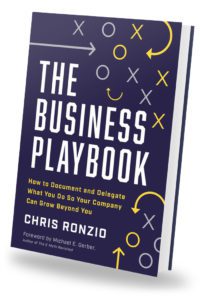Trainual founder and CEO, Chris Ronzio discusses how you can establish business processes and delegate tasks to your business.
Listen to the podcast here:
Download the audio file here.
How & Why We Need to Delegate & Prioritize Processes—with Chris Ronzio
Our guest Chris Ronzio. He is the Founder and CEO of Trainual. A leading SaaS platform that transforms the way small businesses onboard train, and scale their teams. He is the host of The Fastest Growing Companies and Organize Chaos podcasts as well as the author of the best-selling book The Business Playbook: How to Document and Delegate What You Do So Your Company Can Grow Beyond You.
I love this episode because this is for our leaders that are looking to scale and grow their company, how to grow about documenting new processes so you could start delegating it to your team. It’s so important for scalability to have the proper systems in place. In our interview, he discussed the exact process you need to do to start looking at what to delegate and how to go about the navigation and also, the exact steps you need to do to come out with the proper SOPs for your company. This is a great episode for every leader and every business owner. Without further ado, here is my interview.
—
Chris, thank you so much for joining me on the show.
Thanks for having me. Let’s talk business.
We’ve got introduced by somebody that was actually a guest, Naftali Tessler, that was a great friend of the show and he said we’ve got to talk. we spoke and found out that the circle is smaller than we thought originally. For our readers, give us a little bit of the back story about how you’ve got into business in general, entrepreneurship, and ultimately, what you are doing.
I have been an entrepreneur for as long as I can remember. My first real business was when I was fourteen years old. It was a video production company that filmed youth sporting events. I was in high school at the time, and I realized that games and tournaments were the first recurring revenue that I was ever exposed to. We would book a contract with an organization. We would film the events, sell copies to parents, judges, and scouts, stream it to the Jumbotron, and then we would do those events over and over again.
Through high school and college, I built the business muscles for the first time. I learned how to one by one, get myself out of those roles to stop operating the camera, editing the videos, and selling the events so that I could build a team and a business. In doing that, I built a specialty, in SOP systems, processes, operations, writing instructions for how you do what you do.
Fast forward years later, I sold the video company. I consulted for other businesses who all just wanted this turnkey operation. I saw every small business wants to package up how they work, what their playbook for their businesses. There was no great tool that was leading the market to do that. That’s what Trainual is, which is my business.
What excites me about this episode is that this is an untapped conversation and people in businesses don’t realize the benefit of standard operating procedures. Creating that for your new employees, existing employees and so on. We don’t realize how much time gets wasted by continuing to retrain or training differently every employee or people doing it differently. We will get into a lot of details there.

I want to ask you a question. Sometimes we see business owners somehow navigate into a field in a business. In your case, you actually found that pain point for yourself as you were growing your own company. How much have you grown that company based on doing SOP that you said, “I have something over here if we have SOPs, we could grow faster and delegate?”
Trainual as a business, the software company has 81 employees. We have grown to this size over the years. My video company had just over 300 camera operators, again, started with me and a friend in high school. I have seen these stages of growth and how helpful having written instructions are. A lot of people think of SOPs or instructions as this top-down approach. I think of it more as a bottoms-up, everyone that’s brought into a business with some specialization or some ownership over the tasks, the responsibilities that they are doing.
They are responsible for coming up with new best practices, innovating, and creating new ways to do things. As any leader in any company grows their team, you want some consistency on, “Here’s how the company does it. Here’s how we do things,” when you don’t have that explicitly outlined. That’s where you run into these problems with bad performance and, “This person didn’t work out, they are not happy with their job or I can’t find anyone to do this, so I might as well just do it myself.” It all comes back to just having good instructions and clear expectations. That’s what the SOPs are.
This is a very important point for our readers and everybody out there because I always say in leadership events that I speak, it’s very easy to grow a company. It’s managing the growth, which is the hard part. You start up a new company, you are the entrepreneur, the salesperson, the marketing guy, everything else.
All of a sudden, you are starting to bring in people, and then going down and saying, “I need to train people. They need to do it like I should have done it every single step of the process.” All of a sudden, you are not prepared. Therefore, either you have too many people that don’t know exactly what they need to do or too little people because you can’t keep up with demand.
That’s where most companies fail. The statistics that we see out of there are 80% and 90% of businesses fail within years. Those companies have great ideas, revenue but they weren’t able to manage the growth. The mindset of what you are sharing with Trainual and having understanding the concept of SOPs when business owners say, “I need to delegate but I don’t know exactly how to go about it,” or horror stories in the delegation. “I delegate this and they messed up my best client.” A lot of it is in the process of how you go about this. It’s a very important topic that I want to dive deeper into.
I love that you made the point that managing growth is the hard part of the business. As you were talking, I remembered this story when I was a kid. It was before I started my first company. I was probably 12 or 13 years old and one of my neighbors asked me if I would do this little job around his house. If I would carry the firewood from his backyard into this basement that he had. It was a labor job.
[bctt tweet=”Vision work is really important as a blueprint for your success.” username=””]
I started with this huge pile of firewood and would carry 1 and then 2 pieces at a time. I’m filling my arms up with firewood and you only have, as one person, so much capacity. I went home that day and I thought, “How could I make this better?” The next day I brought my wheelbarrow from my house and started supplementing myself with tools. I could take 10 to 15 pieces of firewood from the backyard, and then unload them.
After doing that for a day, I thought, “I can’t push two wheelbarrows, so I need to bring a friend.” I brought a friend. For a lot of entrepreneurs, that’s the process you follow. You start by doing something yourself, you increase your capacity and try to take on more of that burden yourself. You supplement yourself with tools, and then you start to add friends.
The fun part of growing a business is once you’ve got 5, 10 friends, a lot of people. Now, you have to start worrying about shifts, performance management, and a division of roles and responsibilities. “Who’s going to unload the wheelbarrow from the basement? Who’s going to push it across the yard?” The place where a lot of entrepreneurs or business owners maybe get stuck is that hard part that you mentioned of actually managing growth but that’s the part that I love. I’m excited we are talking about this.
Let’s dive in a little bit on the mindset of an entrepreneur. You have spoken to hundreds of business owners throughout the years and work as a company with so many companies. What sets apart the mindset of the entrepreneur or the business leader that sets themselves up for growth versus the ones that are doing it and not figuring out what the next step needs to be?
The difference for an entrepreneur that ends up scaling versus one that is doing the work, the one that gets stuck doing the work over and over again is transactional and they are thinking very short-term. They are thinking, “How do I get the next customer? How do I deliver this job? Where do I get the next job?” They are just on this hamster wheel of getting the jobs done, finding a job, delivering a job.
The ones that have more of the long-term vision that want to jump off that wheel will hire other people to do the work. Even at the short-term expense of personally not making as much money or personally not having as much time because they have to write the training or train that next person, they are willing to make the investment because they see the long-term payoff. That’s the difference that some people get stuck in just doing the work and some people will step back and say, “I’m not going to do the work anymore. I can’t just show up and have a job every day. I need to figure out how to build some structure around this.”

A very important part is that as a CEO and a leader, you always have to separate is, are you focusing on stuff for your company that if you don’t do it, nobody else will? Versus doing the everyday job you probably have at one point, employees or team members that are actually going to be doing that work. We confuse the two. Creating systems and processes in the division for the company and how you want the company to run on the leadership side is way more important for the company because if you don’t do it, nobody else will.
That’s something that leaders always have to ask themselves after a day’s work is, “If the work that I have done, if I have not done it, somebody else could have done it. What did I supplement as with? Where should I focus my time? If I focus there, I know nobody else is focusing there and therefore the company will see tremendous growth in the next couple of months.”
Another difference is that entrepreneurs that end up scaling. I have a vision for that scale. If I had started with the firewood and the logs and thought, “I’m going to have this massive operation with all these people and going door to door and selling the service.” It might have ended up a lot differently. At the time, I did not have that vision at all. It was a one-time job for one neighbor. The people that do scale spend time creating a vision of, “What does this business look like with 10 or 25 people in it?” That vision work is really important as a blueprint for your success.
I want to get into some tactical stuff for our readers. It’s important we pride ourselves on the show that this is no-nonsense advice, literally practical for those readers. You speak a lot about organizing the chaos and delegation. Let’s speak to the leader out there. How do I go about it? We are living in a very fast-paced environment where there’s so much stuff coming your way. What’s the typical structure for a leader to organize their chaos?
First of all, if you’ve got chaos, congratulations. That is a really good thing. A lot of businesses struggle to even get activity going. If you’ve got chaos, that means there are a lot of opportunities. You’ve got customers that want things from you. You’ve got team members that are asking you for things, so chaos is really good in business. If zoom out, someone that has a small business that’s just one person, maybe they are solo or they’ve got a couple of people. The first thing to do is focus on taking an inventory of, “What is all the stuff that I do today?”
If you want to increase your capacity to be able to do more, you have to hand off a couple of things. You can’t do everything in a business. It sounds so easy, such simple advice but I would do is just take a blank sheet of paper or a document and go through what a normal day is like. Anyone reading, what do you start the day with? Are you checking emails, depositing checks, turning on the lights in the warehouse or calling customers? What are you doing?
[bctt tweet=”The context around a process is almost equally as important as the steps of how to do it.” username=””]
All of those activities, then look at what you are doing weekly, monthly, quarterly and yearly. If you just think about that for 15 or 20 minutes, you will come up with a list of dozens and dozens of different tasks that you do in the business. Your first job is to start to rank order those tasks and say, like you mentioned, “Here’s the thing that no one else will do. Here’s the thing that someone else I could hand off to an existing team member, find a virtual assistant, bring on someone part-time or have a family member.” You’ve got to free up some capacity for yourself. Whatever stage the reader is at here, I would say take inventory of what your day-to-day is like and start to think about, “What can come off my plate so that I have capacity or room to grow?”
Let’s take this a step further which is, at one point, we want to start delegating. We all know some people are terrible at delegating and the art of delegations really separates those phenomenal leaders. They are able to literally give over a project, and then they inspect what they expect. What would be the steps to properly delegate?
If you are delegating, you can either delegate a task or responsibility. Where a lot of people get stuck is they delegate these one-off tasks. “Can you go deliver this package, email or call this customer?” If you are delegating tasks, then as soon as the person accomplishes the task, they come back to you looking for more work. They are asking, “What do I do next?” Whereas if you can delegate an area of responsibility in the business and say, “As part of your regular job, you do this every day, every week or you own this input anytime packages come in the mail, that’s you.”
You are starting to shed responsibilities and help your people be more autonomous. The first thing I would say about delegation is to think about responsibilities areas they can take over and not just one-off tasks to accomplish. The next piece is, any area of responsibility, you’ve got to provide some training, instruction for what your expectations are. If it’s something that you have done previously that you are delegating, take the time to record a video or write down a process and share, “This is how I have done it. This is my best practice.”Give it to the person so they can start testing it and asking questions.
Their questions help you fill in the gaps and what you end up with is a well-documented standard operating procedure, whether it’s a video, something in writing or some screenshots. That is the best practice for them to take ownership of. Now you have created some alignment, expectations, and you can inspect what you expect because if you don’t create that expectation, it’s hard for you to hold people accountable for delivering a result. If you say, “Can you do this and I don’t give you an expectation? How can I be mad at you when you don’t do it right?” It’s refining a management skill to give really clear instructions.
Based on what you said, I want to ask you the question because I have heard it from other entrepreneurs in the past. When you are starting to build out a team, there are people that you trust and you can give them full projects and responsibilities. There are people that will be great at just delivering tasks. Sometimes these are VAs or even people internally. Does a healthy culture have a mixture of both? Do we have to expect everybody to be able to do projects when you start delegating?
The more senior a role is the more autonomous they will be and the bigger areas of responsibility they will have. If it’s a VA or an assistant, there is a level of tasks but if it’s 100% tasks, then it almost takes more work for you to have that person. It adds more to your plate to give them tasks and review those tasks.
If you didn’t have it or do them yourself, what you are trying to do is create some leverage and capacity for yourself. To do that, you have to come up with regular tasks. You have to explain what’s going to fill the time of their day is so that they are not always looking for something to do for you. It’s different if you are using a service that’s charging you $10 a request and it’s only on demand. It’s fine if it’s all tasks, “Research travel for me, or book this restaurant,” but if you are starting to employ someone with a full schedule, you need to create what they are going to use all their time for. You’ve got to give them some more autonomy. Otherwise, it takes up more of your time.
I want to go back to the SOPs and Trainual in general. One of the places where I find a very important part, it’s called the Mass Resignation where people call it out there in the media. The companies that are still running and being able to attract great talent are obviously based on the culture and how they were able to hire and retain great employees.

I have seen in the past is the onboarding experience for new employees is sometimes the, “Make it or break it,” how their career will be with that company and how they get onboarded. How much of those SOPs are in Trainual, what advice would you give how an onboarding process needs to look like for new employees?
Onboarding is a make-or-break experience. It either confirms or ruins the experience that they had during their interview process. When you offer them the job, they have a perception of what it’s going to be like to work for the company but until they get in there, they won’t truly know what it’s going to be like. At a training for all of our new people, they go through a two-week process of getting to know the company, the history, the background, the culture, our story, our values, mission or vision.
They meet all of their coworkers. They meet different team leaders and are really getting indoctrinated into the business more so than their individual roles. By the end of that two weeks, that’s where they are just starting to turn the corner to deliver anything or start working on the job that they were hired to do. They understand it, they have been exposed to it but it has been mostly about the culture of the team and the business.
We actually do something at the end of that two-week process, where we offer people $5,000 to quit. We offer them this opportunity to either double opt-in and say, “Yes, I accepted the job offer,” and two weeks later having experienced the culture, I actually want to be here or this isn’t exactly what I thought I was getting into. I had three other offers. I should have taken this other job, and I’m going to walk away gracefully.”
Either option is fine because if they take that offer and leave, then it means we saved ourselves the trouble of seeing that person walk away in 6 or 12 months, once we have invested a ton in them. We have a pool of other candidates that we could have offered the job. What we have done is accelerate that choice so that they are double opting into the culture but I agree with you. That orientation experience is your chance to provide every new person a consistent experience to share your culture and make sure that they are where they are supposed to be.
Let’s talk about that $5,000 incentive to leave. Did UCFO approve that?
Yes, it started at $2,500. No one was taking it, so we actually upped it to $5,000 and still, no one has taken it. The reason for doing that was we looked at our average salaries and we thought, “We want this to be a sizeable enough offer that someone can’t just make more money by sticking around and looking for a job while they are collecting a paycheck.” We wanted it to be a good chunk of money that they could justify that, “I’m going to take the next few weeks off and sort this problem out.”
At the end of the day, regardless of what type of position you take, those people are spending 6, 8, 10 or whatever amount of hours a day, sometimes even more than they spend with their family. It’s important that we are surrounding ourselves with the right people. They are going to be responsible to speak to your customers. They are going to be responsible to see the growth of the company.
I posted on LinkedIn, “Happy team members make happy customers, which make happy shareholders.” It goes in that order. It starts with the people. If you bring in the wrong people on the front end, all of the other stuff just follows. All of a sudden, you have grumpy customers and P&L at the end of the year.
I want to speak about more best practices for a business owner that have never done SOPs or never done a system like that. The hesitation that people have is a very cumbersome type of process. All of a sudden, I have to have all my thoughts and every single step in the way to figure it out. What are some best practices for somebody that has never done SOPs? How to start going about it to get something? I always say, “Version one is better than version none.”
You just get something written down because like I said before, you will get questions about it. It will fill in the gaps, it will get better with every iteration. I’ve got a framework, an SOP for doing SOPs so I can share what that looks like. First, every process, every SOP has a name. What is the task or responsibility in the business? How are you going to find it if you are looking through your files? What is the process? Is this answering the phone when customers call? Is it taking out the trash or doing a client presentation?
[bctt tweet=”You should have 50-80% of your business documented because the rest is your experimentation and innovation.” username=””]
Whatever it is, it usually has some verb at the beginning. Next, really important, “Who owns it?” A lot of people might do it in the business but someone should be the owner of it, meaning this is the person to go to for questions to make it better. This is the person that’s in charge of updating it, that is responsible for it being done right, and that’s going to be held accountable if you are measuring it across a lot of different people. Who owns the process?
The next one is, “What tools are required to do this process?” It may be certain software tools you use. URLs, passwords, maybe hardware tools in the real world that you need to get this done, there may be templates like a company letterhead or a presentation template that you need to use. There should be a list of any tools that people have. Next, you want to know how often this is done. “Is something in the business that is done on demand any time the phone rings, something that’s done every Friday at 5:00 PM or that’s done every morning at a certain time?”
After that, the next question is, “How long should it take to do this if done right? Is this a 5-minute, 30-minute or 3-month task?” Setting some expectations on the time is really important. How is it measured? What does success look like? Is there a speed to reply to a ticket for your customer support people? Is there a grade you get from your customers? What does success look like?
The last one is, “Why does it matter to the business? Is there any other context around this?” If you don’t do this on time, then it messes up the accounting department for X, Y and Z reasons. The final thing is the steps. “How do you do it?” Steps 1, 2 and 3. The reason I share that whole framework is the context around a process is almost equally as important as the steps of how to do it. If you don’t have all of that context and you’ve got some instructions and you don’t know how often to pull out the instructions or why you are even doing this thing? It’s part creating the picture around the process, and then part the sequence of steps to do it right.
This framework is great. I have never heard it that way. People sometimes forget about how success looks like, what are the metrics behind that task? They would become very down to the steps and outlining that is very important. If you have it down to that level of all these different steps, and then sometimes even if you have one person doing it at one point, the person again becomes too busy, they could start giving away certain steps to somebody else. When you are speaking about delegation, going back to the conversation we had earlier that some people are great at tasks. You could say, “Step 4 to 7, those are the steps that you do.”
I will share with our readers that this show has 32 steps. Every episode that I do, believe it or not, has 32 steps on the SOP. The third person took over most of those steps in the process but the transition was so easy as pie because they were just following the SOP. “Here’s how we cut the videos, here’s the vendor that we are using to upload, here’s how we sync it up, and here is how we let our guests know about that when it went live.” All these different steps, some of them are texts. Others have videos to it with screenshots. A fun fact there. People who hear a show don’t know it’s 32 steps to go inside the show. Outside of the effort in finding the right guests like you and all the other guests out there.

That’s such a clear example, too. Anyone that’s reading to this episode can zoom out and think about, “There’s booking a guest, scheduling, cutting up the clips, recording it and a sequence to all that stuff.” It’s the same sequence for all the things that are in a business.
How often do you feel that SOPs need to be reviewed and updated? Is there a sequence or a process that you feel is the best practice?
There are two kinds of variables. How quickly are things changing in your business and how many people are you bringing into the business? How frequently are you hiring? A company that is in a traditional industry with pretty set-in-stone processes, and maybe a controlled environment, and they are not hiring much. They are not going to change all that frequently. You may visit things quarterly or once a year. If you are a business that is hiring ten people a month, and you are constantly branching into new roles and new teams, you are going to be constantly in the weeds updating processes.
The good thing is with a larger team, you have more people that are bottoms up responsible for keeping their areas of the business updated. The unfortunate answer is there’s this big spectrum. For anyone reading, think about how things are changing in your business. As a rough range, you should have 50% to 80% of your business documented. The rest is your experimentation, innovation, and the space in your company where it doesn’t make sense to write things down yet because it’s not consistent.
If every process has a direct, responsible individual, that’s responsible for that, they know what changes in that process. It’s not like the company has processes. The company has a place where we keep our processes but there are individuals that are responsible to make sure that those processes are updated. If not, you bring in a new person and give them a manual and the date on that is 2017. A lot of things changed, including the clouds that we are using since then.
One more question on this. Who is too small, too soon to start doing SOPs? Meaning to say from a size perspective or a company just starting. Who would you say is ready for a system like Trainual versus you start and have some Google docs or how you start keeping tab? At which point do you make the transition to a system like Trainual?
When you have 1, 2, 3 or 4 people, it’s really important to start to build the muscle of delegation and to start delegating tasks as we talked about earlier to bring on a VA or something like that. The reality is the delegating responsibilities or areas of ownership in the business, you are creating your foundational departments when you’ve got 3, 4, 5 or 6 people. It’s that next step of once you have 5 or 6 people and you are starting to build teams, that’s when organizing all of the roles and responsibilities starts to get more intricate.
If you’ve got a handful like three of you, start writing down things in Google or start getting comfortable delegating tasks. As you are starting to build teams and designate who does this versus who does that, and you want to get more granular with your organization, that’s when a system to manage it really helps.
Where could people find out more about Trainual?
It’s at Trainual.com like a training manual so you can check that out. You can check out my book, The Business Playbook at TheBusinessPlaybook.com. That has all of these instructions for how to start doing this, whether you use a system like Trainual, pen and paper or spreadsheets. It’s important you start capturing the knowledge of your business.
As I have mentioned before, “Version one is better than version none.” Let’s close with the four rapid-fire questions. Number one, a book that changed your life.
Built to Sell by John Warrillow.
Number two, a piece of advice you’ve got that you will never forget.
“Your network is your net worth.”
Number three, anything you wish you could go back and do differently?
No, I like how I have done everything.
Last and final question, what’s still on your bucket list to achieve?
I’m translating my book into multiple languages, so I want to start doing more international speaking and that’s soon to come.
Chris, thank you so much for joining us. I know your time is valuable. That is why in the name of our readers, we will forever be grateful for sharing some of your time with us.
Thank you so much. This was great.
Important Links:
- Trainual
- The Fastest Growing Companies
- Organize Chaos
- The Business Playbook: How to Document and Delegate What You Do So Your Company Can Grow Beyond You
- Naftali Tessler – Past Episode
- Built To Sell
- @ChrisRonzio – Instagram
About Chris Ronzio
 Chris Ronzio is the founder and CEO of Trainual, a leading SaaS platform that transforms the way small businesses onboard, train and scale their teams. Chris is the host of “The Fastest Growing Companies” and “Organize Chaos” podcasts as well as the author of the best-selling book “The Business Playbook – How to Document and Delegate What You Do So Your Company Can Grow Beyond You.”
Chris Ronzio is the founder and CEO of Trainual, a leading SaaS platform that transforms the way small businesses onboard, train and scale their teams. Chris is the host of “The Fastest Growing Companies” and “Organize Chaos” podcasts as well as the author of the best-selling book “The Business Playbook – How to Document and Delegate What You Do So Your Company Can Grow Beyond You.”








